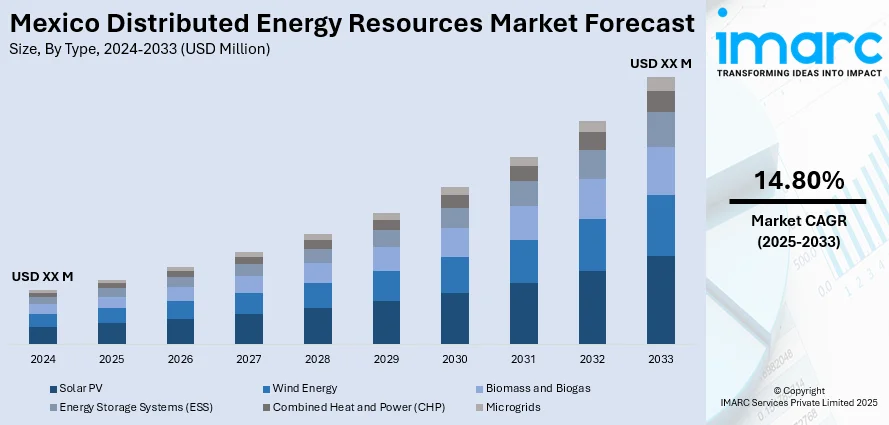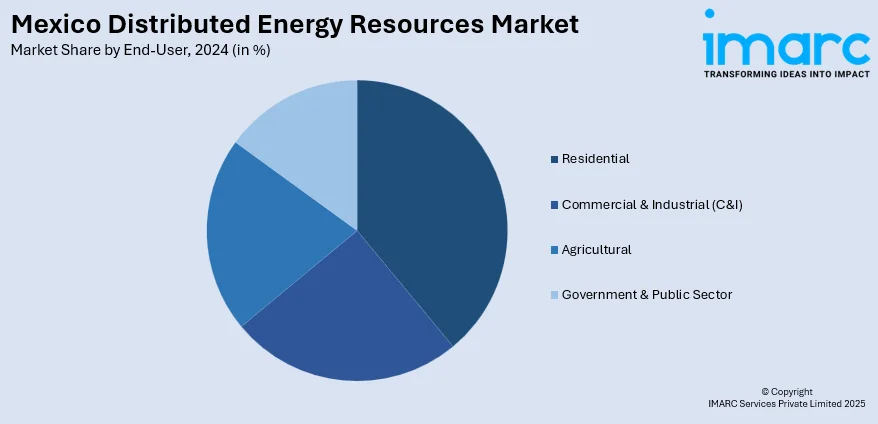
Mexico Distributed Energy Resources Market Size, Share, Trends and Forecast by Type, Connectivity, Technology, End-User, and Region, 2025-2033
Mexico Distributed Energy Resources Market Overview:
The Mexico distributed energy resources market size is projected to exhibit a growth rate (CAGR) of 14.80% during 2025-2033. The market is driven by rising electricity demand, supportive government policies, advancements in energy storage and smart grid technologies, and growing investment in renewable energy. Increasing focus on energy independence and sustainability further accelerates DER adoption across residential, commercial, and industrial sectors. These factors collectively contribute to the steady expansion of the Mexico distributed energy resources market share.
|
Report Attribute
|
Key Statistics
|
|---|---|
|
Base Year
|
2024
|
|
Forecast Years
|
2025-2033
|
|
Historical Years
|
2019-2024
|
| Market Growth Rate 2025-2033 | 14.80% |
Mexico Distributed Energy Resources Market Trends:
Rapid Growth in Distributed Solar Energy
Mexico is experiencing a profound shift towards decentralized solar power, promoted by increasing electricity prices, increased environmental consciousness, and energy independence desires. The solar systems are becoming increasingly popular because of their ease of installation and configurability, which makes them very appealing for individuals, companies, and communities. With growing adoption, decentralized energy generation pushes itself even further. In 2024, Mexico installed 1.09 GW of distributed solar capacity, a 35% increase over the prior year, to a total of 4.42 GW with more than 500,000 interconnection contracts. This transition is in support of sustainability objectives but also poses challenges to grid management, requiring new policies for safe and efficient integration. It is part of a larger trend toward cleaner, localized energy solutions throughout the country.

Regulatory and Infrastructure Challenges
The growth of distributed energy in Mexico is also confronted with significant regulatory and infrastructural issues that may impede long-term development. Existing regulations restrict the size and character of distributed energy systems, making it more difficult for larger consumers to switch entirely to renewable energy. Secondly, the nation's outdated and poorly developed grid infrastructure is not well equipped to handle the growing number of decentralized energy sources. These challenges make it uncertain for investors and hinder innovation in the industry. To unleash the full potential of distributed energy, Mexico needs to update its energy policies and invest in upgrades to the grid. Without these measures, the DER market is unlikely to be able to keep pace with increasing demand or to support a stable, secure energy system.
Emphasis on Energy Storage Integration
As renewable sources such as wind and solar gain traction in Mexico, energy storage is fast becoming an essential factor in Mexico's energy shift. The authorities are considering the implementation of mandates requiring renewable energy projects to incorporate storage systems that account for up to 30% of their capacity, with the aim of enhancing grid stability and reliability. Energy storage makes it possible to save excess energy to be utilized during periods of low production, providing a stable power supply and smoothing demand. The increasing interest in hybrid solutions that integrate solar generation with battery storage further indicates this direction. Nevertheless, obstacles like high initial investment and uncertain regulatory conditions slow down adoption. These challenges must be addressed to develop a robust and sustainable distributed energy system in Mexico, which will ultimately drive the country towards its renewable energy objectives.
Mexico Distributed Energy Resources Market Segmentation:
IMARC Group provides an analysis of the key trends in each segment of the market, along with forecasts at the country and regional level for 2025-2033. Our report has categorized the market based on type, connectivity, technology, and end-user.
Type Insights:
- Solar PV
- Wind Energy
- Biomass and Biogas
- Energy Storage Systems (ESS)
- Combined Heat and Power (CHP)
- Microgrids
The report has provided a detailed breakup and analysis of the market based on the type. This includes solar PV, wind energy, biomass and biogas, energy storage systems (ESS), combined heat and power (CHP), and microgrids.
Connectivity Insights:
- On-Grid
- Off-Grid
- Hybrid Systems
A detailed breakup and analysis of the market based on the connectivity have also been provided in the report. This includes on-grid, off-grid, and hybrid systems.
Technology Insights:
- Distributed Generation
- Distributed Storage
- Demand Response Technologies
- Smart Grid and IoT Integration
The report has provided a detailed breakup and analysis of the market based on the technology. This includes distributed generation, distributed storage, demand response technologies, and smart grid and IoT integration.
End-User Insights:

- Residential
- Commercial & Industrial (C&I)
- Agricultural
- Government & Public Sector
A detailed breakup and analysis of the market based on the end user have also been provided in the report. This includes residential, commercial & industrial (C&I), agricultural, and government & public sector.
Regional Insights:
- Northern Mexico
- Central Mexico
- Southern Mexico
- Others
The report has also provided a comprehensive analysis of all the major regional markets, which include Northern, Central, Southern Mexico, and Others.
Competitive Landscape:
The market research report has also provided a comprehensive analysis of the competitive landscape. Competitive analysis such as market structure, key player positioning, top winning strategies, competitive dashboard, and company evaluation quadrant has been covered in the report. Also, detailed profiles of all major companies have been provided.
Mexico Distributed Energy Resources Market News:
- In April 2025, Revolve Renewable Power Corp. is accelerating development of its two major wind projects in Mexico—El 24 (131 MW) and Presa Nueva (400 MW)—thanks to improved regulatory clarity. Located in high wind zones in Tamaulipas and Nuevo Leon, both projects are advancing through permitting, interconnection, and design optimization. These developments align with Revolve’s “develop and sell” strategy, reinforcing its commitment to utility-scale renewable growth and distributed generation expansion in Mexico.
- In March 2025, Odyssey Energy Solutions expanded into Mexico, launching its finance platform to support the country’s booming distributed solar market. With rising energy costs, regulatory support, and strong solar potential, Mexico offers ideal conditions for growth. Odyssey’s platform includes embedded supply chain credit, helping EPCs and developers overcome financing barriers by enabling seamless procurement and project execution. This move aligns with Odyssey’s global mission to accelerate capital deployment into distributed energy.
Mexico Distributed Energy Resources Market Report Coverage:
| Report Features | Details |
|---|---|
| Base Year of the Analysis | 2024 |
| Historical Period | 2019-2024 |
| Forecast Period | 2025-2033 |
| Units | Million USD |
| Scope of the Report |
Exploration of Historical Trends and Market Outlook, Industry Catalysts and Challenges, Segment-Wise Historical and Future Market Assessment:
|
| Types Covered | Solar PV, Wind Energy, Biomass and Biogas, Energy Storage Systems (ESS), Combined Heat and Power (CHP), Microgrids |
| Connectivities Covered | On-Grid, Off-Grid, Hybrid Systems |
| Technologies Covered | Distributed Generation, Distributed Storage, Demand Response Technologies, Smart Grid and IoT Integration |
| End-Users Covered | Residential, Commercial & Industrial (C&I), Agricultural, Government & Public Sector |
| Regions Covered | Northern Mexico, Central Mexico, Southern Mexico, Others |
| Customization Scope | 10% Free Customization |
| Post-Sale Analyst Support | 10-12 Weeks |
| Delivery Format | PDF and Excel through Email (We can also provide the editable version of the report in PPT/Word format on special request) |
Key Questions Answered in This Report:
- How has the Mexico distributed energy resources market performed so far and how will it perform in the coming years?
- What is the breakup of the Mexico distributed energy resources market on the basis of type?
- What is the breakup of the Mexico distributed energy resources market on the basis of connectivity?
- What is the breakup of the Mexico distributed energy resources market on the basis of technology?
- What is the breakup of the Mexico distributed energy resources market on the basis of end-user?
- What is the breakup of the Mexico distributed energy resources market on the basis of region?
- What are the various stages in the value chain of the Mexico distributed energy resources market?
- What are the key driving factors and challenges in the Mexico distributed energy resources?
- What is the structure of the Mexico distributed energy resources market and who are the key players?
- What is the degree of competition in the Mexico distributed energy resources market?
Key Benefits for Stakeholders:
- IMARC’s industry report offers a comprehensive quantitative analysis of various market segments, historical and current market trends, market forecasts, and dynamics of the Mexico distributed energy resources market from2019-2033.
- The research report provides the latest information on the market drivers, challenges, and opportunities in the Mexico distributed energy resources market.
- Porter's five forces analysis assist stakeholders in assessing the impact of new entrants, competitive rivalry, supplier power, buyer power, and the threat of substitution. It helps stakeholders to analyze the level of competition within the Mexico distributed energy resources industry and its attractiveness.
- Competitive landscape allows stakeholders to understand their competitive environment and provides an insight into the current positions of key players in the market.
Need more help?
- Speak to our experienced analysts for insights on the current market scenarios.
- Include additional segments and countries to customize the report as per your requirement.
- Gain an unparalleled competitive advantage in your domain by understanding how to utilize the report and positively impacting your operations and revenue.
- For further assistance, please connect with our analysts.
 Request Customization
Request Customization
 Speak to an Analyst
Speak to an Analyst
 Request Brochure
Request Brochure
 Inquire Before Buying
Inquire Before Buying




.webp)




.webp)












